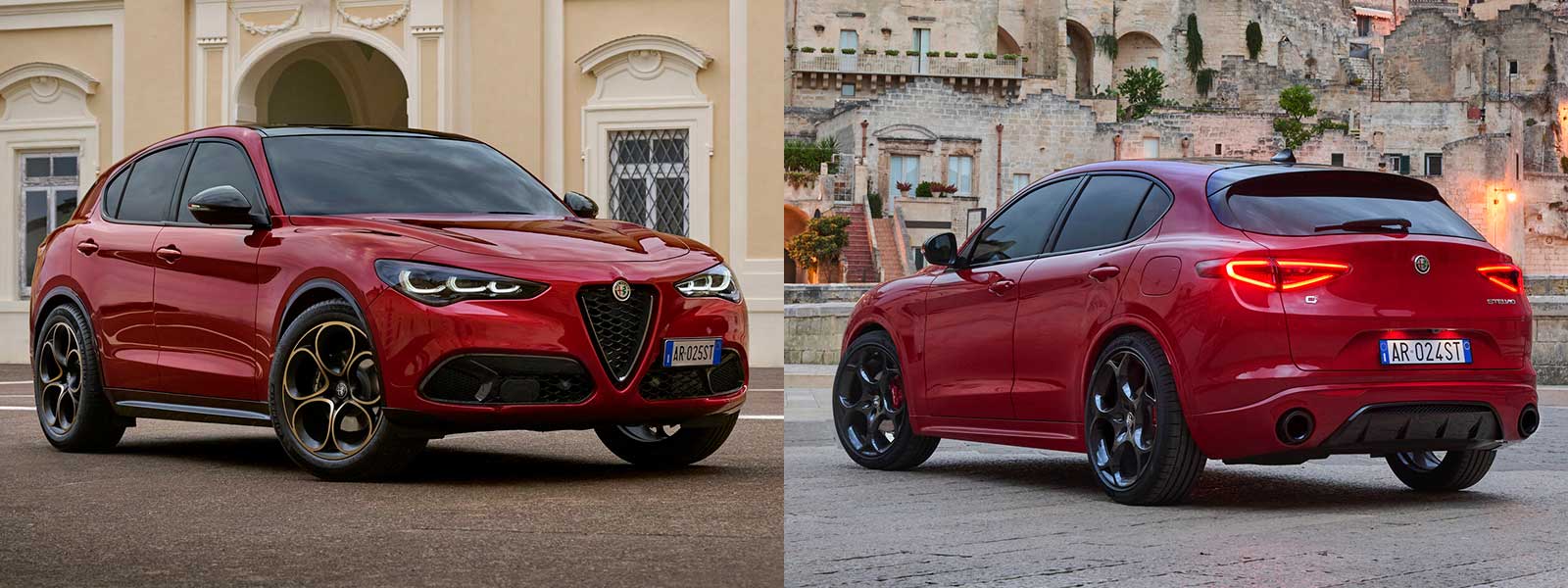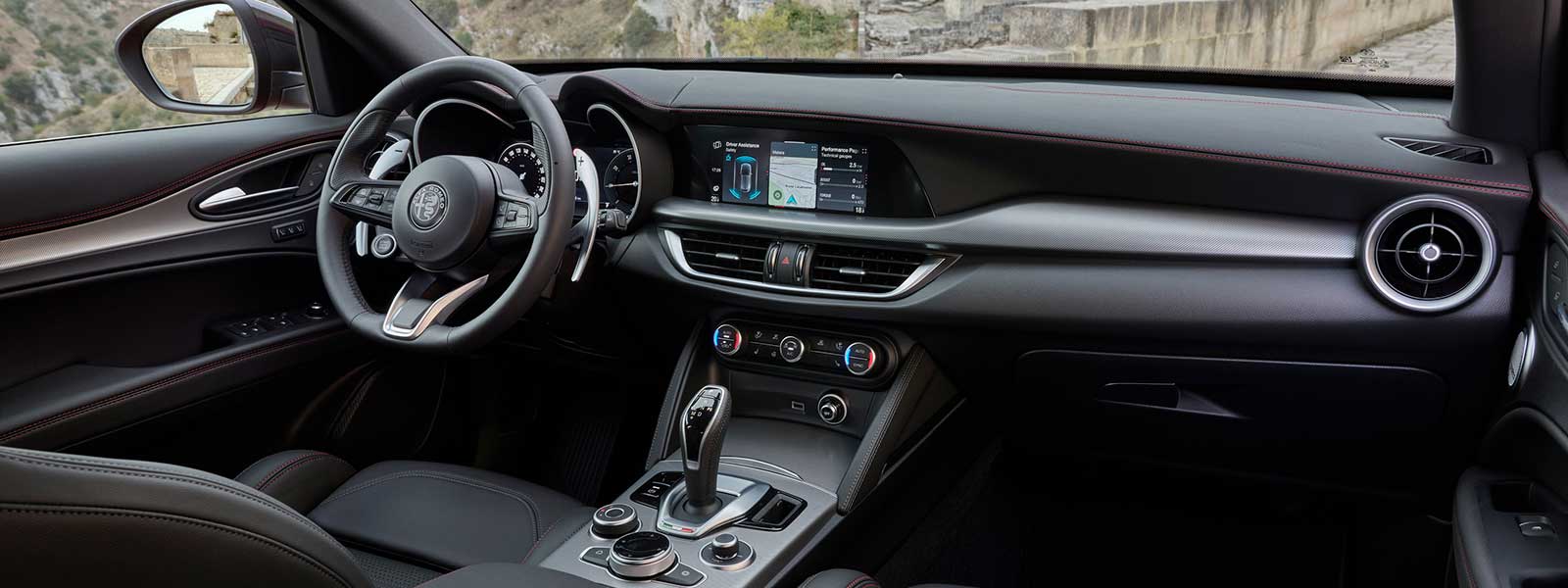2025 Alfa Romeo Stelvio
Stelvio loses its beating heart, but it's still a very sporty crossover.
The Alfa Romeo Stelvio, first introduced in 2016, has been a standout in the luxury compact crossover segment, blending Italian design with sporty performance. The 2025 model continues this legacy, offering seating for up to five passengers and maintaining its 5-passenger, 4-door wagon body style. Rivals include the Audi Q5, BMW X3, Genesis GX70, Infiniti QX50, Lexus NX, Mercedes-Benz GLC, Porsche Macan and Volvo XC40.
For 2025, the Stelvio is available in two trims: the base model and the Tributo Italiano. Both trims feature a turbocharged 2.0-liter four-cylinder engine producing 280 horsepower and 306 lb-ft of torque, paired with an eight-speed automatic transmission. Gone for 2025 is the Ferrari-derived 2.9-liter twinturbo V6. The Stelvio also boasts a towing capacity of up to 3,000 pounds.
Pricing for the 2025 Alfa Romeo Stelvio starts at $48,995 for the base model and goes up to $55,995 for the Tributo Italiano. Standard safety features include adaptive cruise control, lane departure warning, forward collision warning with automatic braking, and blind-spot monitoring. Available options include a panoramic sunroof, premium audio systems, and advanced driver assistance packages, allowing buyers to customize their Stelvio to suit their preferences.

With the departure of the V6 engine, Stelvio officially loses its "bad-ass crossover" rating. That engine enabled the Stelvio to claim the "World's fastest production SUV" for a time. That's not to say that the base engine is underpowered, it's just not as thrilling from a driver's perspective. The base 2.0-liter turbo four provides ample thrust with plenty of get-up-and-go off the line and solid passing punch. Most peg the 0 to 60 MPH time under 6 seconds.
The engine mates mate well to the slick-shifting automatic transmission and the all-wheel-drive system does a good job of sending power to the wheels with the most traction. As is the case with most luxury crossovers, the Stelvio does not offer low-range gearing for extreme off-road use and its all-wheel-drive system is intended to provide a bit more security on slippery or snow-covered roads.
The 4-cylinder Stelvio is rated at 22 MPG city and 29 MPG highway (28 w/AWD) and requires premium-grade gasoline. The 4-cylinder gets better than average fuel economy for the class. In routine suburban commuting, it is possible to average about 25 MPG overall. Straight highway driving yields about 28 MPG overall.
All of Stelvio's light-weighting tricks add up to a crossover that not only holds the road well but is also a delight to drive on twisty roads. On most models, the suspension provides enough impact absorption to prevent the ride from growing harsh over badly broken roads and enough composure to keep occupants from bouncing when going over curbs or around corners.
The steering is delightfully quick, but never darty. It's precise and has a good heft that makes you feel like you are driving a sports car. The powerful brakes can seem grabby but provide ample stopping power. After some time for acclimatization, drivers can pull off smooth stops. Interior noise levels are surprisingly low, with just a hint of engine growl and exhaust note around town. Crack the whip though, and Stelvio lets you know its performance-car upbringing.

Stelvio boasts an interior that's a cut above the mainstream, but not quite premium. (And that's where Alfa is positioned in Italy.) Materials are price appropriate and get nicer as you go up in trim. The design and layout are very functional and make for a driver-orientated experience that's easy to pick up and operate.
The digital instrument cluster is customizable, but the analog gauges were more appropriate in a sporty crossover. (Thankfully, there are analog dials on the digital screen.) The steering wheel has refreshingly few buttons and knobs, but an interesting START ENGINE button that's very racecar like. All models get a somewhat small infotainment touchscreen that can also be operated by a jog dial. Android Auto and Apple Car play are supported, but only by cable. The climate controls are super simple and nicely arranged in an easy-to-reach location on the center stack. Ancillary controls are conveniently placed and easy to operate.
The front seats are heavily bolstered. Some might find them too firm, especially if you are outside the typical body shape. Head and leg room are quite good given Stelvio's sporting intentions. The rear seats can be adult friendly if the front seats are moved forward a bit, but don't offer much knee or foot space and head room is at a premium for taller folk. Two adults can fit, but Stelvio does not lead the class in rear-seat room.
Outward visibility is excellent to the front and sides and somewhat pinched to the rear thanks to the smallish rear window and thick rear pillars. Even though this is crossover, getting in and out can be tough because the door openings are not all that wide, and the roofline is fairly low.
With just 18.5 cubic feet of storage behind the rear seats, Stelvio isn't the most utilitarian crossover in its class. Thankfully the opening is wide and the load floor low. Fold the rear seats down and cargo space grows to 56.5, which is average for the class. Interior storage is modest with just one open bin in the console and a shallow glove box.
Bottom Line -- Alfa is a relatively new brand to American buyers, but it is certainly one that's worth consideration. Simply put, Alfa makes vehicles for enthusiasts. The Stelvio is a perfect example, it's a joy to drive, even more so when you pick up the pace. Other attributes include reasonable passenger space and affordable pricing for the segment. True, cargo and rear-seat space are modest. All in all, one drive is all it should take to convince most shoppers to become buyers.
